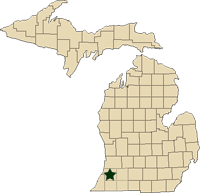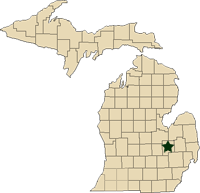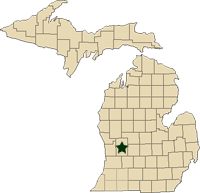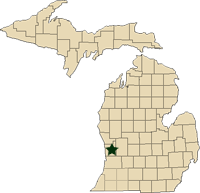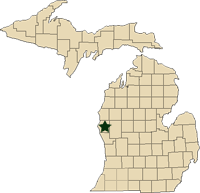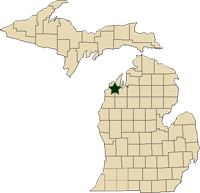Regional reports on Michigan fruit – June 28, 2011
MSU Extension educators’ pest and fruit updates for Michigan
This week’s regional reports:
- Southwest Michigan - Mark Longstroth, Bill Shane, Diane Brown-Rytlewski
- Southeast Michigan - Bob Tritten
- Grand Rapids Area Tree Fruit - Amy Irish Brown and Phil Schwallier
- Grand Rapids Area Small Fruit – Carlos García-Salazar
- West Central Michigan - Mira Danilovich
- Northwest Michigan - Nikki Rothwell, Duke Elsner, Erin Lizotte
Southwest Michigan – Mark Longstroth, Bill Shane, Diane Brown-Rytlewski, Michigan State University Extension
|
Hot weather marked the start of last week with highs near 90 on Monday and Tuesday (June 20-21). Tuesday evening brought storms with strong winds and rain. Hail in central Van Buren County caused significant damage to fruit in a narrow path running north-northwest from south of Hartford to southwest of Bloomingdale. Wednesday through Friday was cool and wet with intermittent rains and long wetting periods. Drier and warmer weather over the weekend was pleasant with highs in the 70s and 80s. Rainfall for the week was about an inch. The top soil is moist but will dry quickly. Soil temperatures are in the mid-60s. We are close to normal fruit development, but growing degree accumulation for 2011 is well behind the five-year average. Check for the closest weather station at Enviro-weather.
| Southwest Michigan Growing Degree Day Totals from March 1 through June 26, 2011 | |||
| Location | GDD 42 | GDD 45 | GDD 50 |
| Bainbridge | 1433 | 1204 | 870 |
| Trevor Nichols | 1308 | 1094 | 779 |
Tree fruit
Hail damage to tart cherries and apples was severe in central Van Buren. San Jose scale crawlers are out. Birds are feeding on ripening cherry fruit. Potato leafhopper damage can be found in many crops. Cherry fruit flies and apple maggots are out.
Apricots are almost 2 inches in diameter. Early varieties are ripening and harvest has begun.
Peaches are about 1.5 inches in diameter. Crop looks good and growers are thinning fruit. Estimated start of Redhaven harvest for Berrien County is August 4, near the long term average and about seven days later than 2010. Pit hardening has begun. Oriental fruit moth trap catch is declining and the first flight is ending. Growers and scouts should change their trap lures for the flight of the second generation. Tarnished plant bug feeding is declining. Trunk sprays for borers are typically applied before early July. Bacterial spot symptoms on leaves and rusty spot symptoms on fruit are easy to find in some orchards.
Sweet cherry harvest has begun with the harvest of Chelan, Early Star, Black Pearl, Cavalier (Rembrandt) and other early varieties. Birds are a real problem feeding on ripening cherries. Sweet cherries are very susceptible to brown rot as they ripen. Fruit lesions caused by bacterial canker are especially susceptible to brown rot infection. Cherry fruit flies have been trapped at the Trevor Nichols Research Complex near Fennville.
Tart cherries are well-colored and growers are applying ethephon. Harvest will begin after July 4, which is later than normal. Last week’s storms caused significant damage in some tart cherries orchards and brown rot infections are established. Growers need to be sure their crop is protected from brown rot and cherry fruit fly. Cherry leafspot symptoms are becoming easier to find.
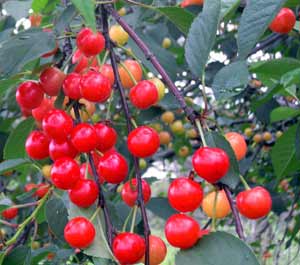
Tart cherry harvest will begin next week.
Plums are an inch in diameter. Most shoot growth has stopped, so black knot control is less important.
Apples are 1.25 to 1.5 inches in diameter. It is too early to see the results from Tuesday’s storm, but new fire blight symptoms from internal and tree-to-tree movement of the disease are apparent. Growers are reporting more and more apple scab. This is probably due more to the wet cool spring and frequent long wetting periods. Good fungicide coverage would have been difficult to maintain and washoff of protectant fungicides was a real problem.
Apple scab symptoms, including pinpoint scab on fruit, are becoming easier to find. Generally, the fruit is resistant at this point in the season, but growers need to continue applying controls to protect the new leaves. Growers should scout for scab lesions and determine if they need to maintain protection against more scab infection. Codling moth trap catches are declining. Codling moth biofix was June 1 or 3. We are about 500 GDD base 50 after biofix and at peak egg hatch. Many growers will be applying their second cover for codling moth soon.
Obliquebanded leafroller biofix in southwest Michigan was June 13. We are about 360 GDD beyond biofix and the obliquebanded leafroller development model on Enviro-weather can be used to determine the timing of controls. Growers and scouts should have apple maggot traps out.
Pear fruit are 1.5 inches in diameter. Pear psylla adults and nymphs can be found. First generation codling moth is generally not a concern in pears, but may be a problem in softer pear varieties. Controls should be applied in some orchards, depending on the insect population.
Small fruit
In grapes, Concord and Niagara fruit are pea-sized berries. Berries of wine grape varieties are buckshot size. We are at 900 GDD base 50 from April 1. We will be at 1200 GDD in about two weeks and grape berries will be about half their final size. We have a very heavy grape crop and the season is shaping up to be a cool season and it will be hard to fully ripen a heavy crop. Growers should consider estimating their crop at 1200 GDD and thinning the fruit down to manageable levels.
Grape berry moth larvae are feeding on grape clusters. Grape berry moth trap catch numbers are down, which indicates the end of the first generation. Growers should plan on applying controls for the second generation. We set biofix for GBM May 30-31 in Berrien County and June 1-2 in Van Buren County. 810 GDD base 47 after biofix marks the beginning of egglaying for the second generation, and the recommended timing for an application of insecticide to control grape berry moth. We are about 570 GDD from biofix and will be 760 GDD past biofix in a week. Sprays to control grape berry moth should be applied in 10 to 14 days. Check the grape berry moth model at Enviro-weather to determine the correct timing for grape berry moth controls for the weather station closest to your vineyard.
Grape leafhoppers and potato leafhoppers are out and signs of feeding can be found. Post-bloom sprays also focus on disease control.Phomopsis symptoms are common, but no new symptoms have been found and the supply of current year’s spores may be exhausted. Black rot and downy mildew symptoms have been observed. According to the black rot model on Enviro-weather, there have been several black rot infection periods within the last couple of weeks. Black rot has been observed at low levels in treated vineyards and at higher levels in untreated research plots.
Downy mildew has been observed infecting rachises of Chancellor grape at high levels in the sentinel plot at SWMREC. The species of downy mildew that infects juice grapes is a different species. It has been found at low levels, but weather conditions have been very favorable for the development of this disease. Growers should protect against all these diseases in their next post-bloom application. Powdery mildew symptoms have not been observed yet.
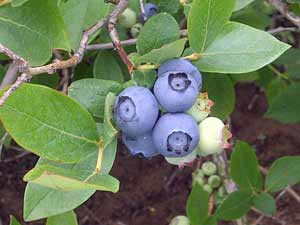
“Duke” blueberries are being harvested in southwest Michigan.
Blueberry fruit are losing their green color and early varieties are coloring. Duke and other early varieties such as Bluetta, Earliblue and Weymouth are being harvested and other early varieties will start this week in Berrien County. Vigorous shoot growth continues in many fields. Cane collapse from phomopsis cane blight has begun. Insects of concern include blueberry maggot and Japanese beetle. Elderberry is at full bloom now and is a useful indicator plant to mark the beginning of Japanese beetle adult feeding. See the article on Monitoring and management strategies for blueberry maggot. Glyphosate herbicide injury symptoms are very common in blueberries this year.
Strawberry harvest is ending. Some U-pick growers have remained open because the late ripening fruits are larger than the small fruit earlier in the season. Harvest should end this weekend and renovation will begin soon. Common leafspot and leather rot have been observed in some plantings.
In brambles, harvest of summer-bearing red raspberries has begun with Prelude. Black raspberry harvest should start next week. Growers should prepare for Japanese beetle.
Southeast Michigan – Bob Tritten, Michigan State University Extension
|
Weather
We have had a series of slow moving strong thunderstorms move through the region over the last week. Several of these storms also contained marble-sized hail. The amount of rainfall and wind varied greatly across the region. I have been on farms in the past week that received no rainfall and are continuing to struggle with dry soils, and others that have had 4.5 to 5 inches of wind-driven rain. These excessive rains have caused several strawberry farms to end harvest early.
Where growers have not received rainfall in the last week, soils generally remain dry and growers are irrigating on a regular basis. Farms that have received heavy amounts of rain are saturated and are concerned about soil-borne root diseases in many of our small fruit crops, especially strawberries and raspberries.
Our season is now almost back to normal in terms of degree day totals. Our harvest season, however, is now running ahead of normal, which is difficult for me to believe. Several growers started sweet cherry harvest on June 24 or 25, which is one of the earliest seasons that they can remember the beginning of sweet cherry harvest.
| Southeast Michigan Growing Degree Day Totals for March 1 to June 27 | |||
| Location | GDD42 | GDD45 | GDD50 |
| Commerce (Oakland) | 1375 | 1160 | 841 |
| Emmett (St Clair) | 1319 | 1107 | 797 |
| Flint (Genesee) | 1397 | 1177 | 859 |
| Lapeer (Lapeer) | 1386 | 1171 | 856 |
| Petersburg (Monroe) | 1499 | 1269 | 926 |
| Pigeon (Huron) | 1211 | 1008 | 714 |
| Romeo (Macomb) | 1348 | 1136 | 824 |
Tree fruits
Apple drop has finally wrapped up across the region. Many growers are now focusing on thinning varieties or trees with a heavy crop load. Varieties that are commonly being hand-thinned include Gala, Fuji and, at some farms, Honeycrisp. Growers need to do a particularly thorough job of thinning Honeycrisp as this variety tends to not come back with a strong return bloom the following year if cropped too heavily during any one season. Fruit size continues to march along quickly, with most fruit being 1 3/8 to 1.5 inches in diameter.
I don’t have any new insects to report in apples this week. With the exception of codling moth and green apple aphids, it is a bit of a slow time at most farms. Some farms have very high trap catch numbers of codling moth. This is the end of the “B” peak of the first generation adult flight. Green apple aphid populations have continued to march along fairly rapidly. I am finding that the aphids are moving off of the terminal leaves and are starting to congregate on fruit at many farms. This is a concern to me and one that growers need to watch carefully as control measures need to take place when aphids begin to appear on fruit. I am seeing a tremendous number of predators feeding on aphids, but their numbers aren’t building fast enough this year to keep the aphids from spreading to the fruit.
Oriental fruit moth and obliquebanded leafroller trap catches are generally down this week. I have not caught any apple maggots. If growers have not set traps, they need to do so as soon as possible. I continue to see a few tarnished plant bugs in apples, however, I don’t feel that they are much of a threat at this time. Potato leafhopper populations continue to slowly build. I see a few European red mite adults and eggs in apples, however, their numbers are generally low. As mentioned earlier, I am seeing excellent predator populations this year and good numbers of lady bird beetles and green lacewings.
Cedar apple rust is the only disease that is showing up more and more in apples over the last week. I have seen symptoms on both foliage and fruit. Apple scab is present in most orchards but does not appear to be spreading. Powdery mildew and fire blight symptoms also appear to be stabilized.
Pears are at about 1.25 inches in diameter. I am encouraging growers to remove suckers from pears at this time as they are an excellent location for pear psylla populations to build for the rest of the summer. I continue to see their populations slowly build, however, pear psylla numbers are generally low this season.
Sweet cherry harvest began late last week at several farms across the region and is getting underway at others in the next few days. This is one of the earliest starts of sweet cherry harvest that many fruit growers can remember. Fruit has sized somewhat over the last week, however, it is still smaller than normal. Both cherry fruit fly and black cherry fruit fly have been caught in traps. They appear to have a strong flight this season.
Brown rot is showing up in low fungicide sprayed blocks or in trees that have not had good coverage. Keep an eye out for brown rot infections. Cherry leafspot infected foliage continues to be seen at several farms. Birds have been a serious issue at several farms across the region. We have good populations of cedar wax wings and robins this year that are feeding on sweet cherries.
Tart cherries are close to being ready for harvest, at most farms it will be about five to nine days away. Tart cherry harvest will also be early this year.
Plums are about 22 mm in size. European plum varieties appear to have a modest crop and many Japanese plum varieties are light.
Small fruits
Strawberry harvest has wrapped up at most farms across the southern part of the region. In the Flint area I expect strawberry harvest to be completed in the next few days or so. Many farms in the Flint area were hoping to get through the rest of the week, but heavy rains at many farms are going to bring a quick end to the season. Small berry size has been a problem at several farms. The strawberry season has been very short at most farms, with the season going about 16 to 20 days. I have seen several farms where leather rot has been an issue due to heavy rainfall and overripe berries. I have also seen strawberries at a good number of farmer’s markets where it appears they have been infected with angular leafspot. Growers that have completed harvest are beginning the renovation process with an herbicide application.
Raspberry growth continues for summer raspberries. I expect the picking season to begin on early sites in the next week. I am seeing high populations of tarnished plant bugs on summer bearing raspberries. Populations have been high enough at most farms that I am recommending an insecticide application. Fall red raspberries have about 30 to 36 inches of growth. I am seeing some tarnished plant bugs on the early fruiting canes of fall raspberries that I have been describing in the last few issues of my reports. Growers need to do a good job of scouting for tarnished plant bug in both summer and fall red raspberries at this time.
Blueberries continue to size quite nicely. At a few farms, rose chafers have damaged blueberry leaves. I have not seen any Japanese beetles nor trapped any spotted wing Drosophila adults. Blueberry maggot traps need to be hung as soon as possible.
Grapes are about buckshot in size. Grape berry moth trap catches are continuing to rise, recall that I set a regional biofix for grape berry moth of June 6th to the 8th. We are about 10 to 14 days away from the second generation control strategies. I am seeing light amounts of powdery mildew in grapes and have not seen any downy mildew.
Grand Rapids Area Tree Fruit– Amy Irish Brown and Phil Schwallier, Michigan State University Extension
|
Tree fruit growth stages
Degree days continue to be very near average for late June. The totals for the Sparta station as of June 27 are 1357 base 42, 1135 base 45 and 812 base 50. Apple size is excellent and the crop is appearing to be at normal fruit set for most varieties. There are a few misshapen fruits in some sites and it looks like frost damage, but it’s a very light amount overall. Hand thinning is underway. Rainfall totals were high from the four days of rain last week (June 19-25).
Tree fruit diseases
Apple scab. There is more scab showing up each week. The four days of rain last week will only cause more. This had been a difficult year to stay ahead of apple scab. Keep watching for it and maintain higher rates of fungicides in blocks with scab present – fruit is still very susceptible.
Fire blight. Very little fire blight is present in orchards. Growers should continue to keep trauma blight in mind if we get storms that cause tissue damage.
Powdery mildew. Continue to monitor for it. The very hot weather later this week will cause even more mildew spread.
Summer diseases in apples. Fungicides need to be added for summer disease prevention.
Brown rot in sweet cherries. Some varieties are already showing pretty bad infestations of brown rot. It is thought that these varieties are susceptible to bacterial canker spots on the fruits that cause a wound, and the brown rot fungus is colonizing this wound. The very wet weather from last week will only enhance brown rot in sweet cherries, so maintain good fungicide cover sprays to prevent it in all cultivars.
Tree fruit insects
Plum Curculio has finally discontinued damaging tree fruits.
Codling moth biofix for the Grand Rapids area was set for May 30. As of midnight, June 27, 471 DD base 50 have been accumulated and it is estimated that egg hatch is at 45 percent. Cover sprays for codling moth are very important in blocks over threshold for adult male moth trap numbers. This is a key time to have good cover sprays on to protect fruit.
Obliquebanded leafrollers are flying regularly. A regional biofix was set for June 14 and 318 DD base 42 have been accumulated since that date. It is estimated that early egg hatch will occur on July 1 based on this biofix and the forecasted temperatures. Growers with problem blocks should consider timing management at this earlier timing. All others can delay their first sprays by a week to 10 days or when they see two to three larvae infested terminals per tree.
European red mites can be found in all life stages. Monitor mites closely as petal fall timed miticides could start to break now that we are four to six weeks past petal fall.
White apple leafhoppers and potato leafhoppers are present in all life stages. Numbers are normal to slightly above normal. Non-bearing trees have higher numbers and controls are needed to prevent shoot growth shutdown.
Oriental fruit moths are in between first and second generations right now and controls are not needed.
Dogwood borers in apples have been flying in very light numbers for the past four weeks. Trunk sprays for dogwood borers in apples should be targeted for peak adult flight, which is usually the first week of July. Try to get that task done by mid-July. The Pre-harvest Interval for truck sprays of Lorsban is 28 days.
Grand Rapids Area Small Fruit– Carlos García-Salazar, Michigan State University Extension
|
Weather in the Grand Rapids region has been hot and humid with temperatures in the upper 70s with some days reaching the low 90s. Rain accumulation during the past seven days has been more than 1 inch. There were some thunderstorms that produced hail in some counties. However, no major damage to crops has been reported by growers. The increase in daily temperatures accelerated plant growth and development. Still, our small fruit crops are two weeks behind in relation to 2010. Degree-day accumulation in the area has reached 840-850 GDD base 50.
Changes in weather conditions have had a positive influence in blueberry growth and fruit development. Blueberries are growing rapidly and fruit in early varieties started coloring and in south Allegan the harvest of early season varieties may start this week.
Some problems observed during this period are related to the opportunity of pesticide applications against fruitworms and plant diseases. Weather and soil conditions prevented some growers from carrying out an effective pest and disease control program. It is important to keep in mind that fruit rots are one our major fruit quality problems. In some instances, a deficient fruit rot control in conjunction with hot weather has been responsible for crop losses amounting to more than 50 percent of harvested fruit. Alternaria and Anthracnose fruit rot are endemic in our blueberry ecosystem. Thus, a timely fruit rot spray program is needed to ensure high fruit quality at harvest time.
In 2010, there were several complaints about “soft” fruit at harvest time and large amounts of fruit already harvested for the fresh market had to be diverted for processing. Diverting fruit harvested for fresh packing to processing signified economic losses because harvesting expenses are different for processing and fresh packing. Therefore, under the present circumstances with high temperatures, scattered rains and occasional hail damage keeping a good fungicide spray program will pay at harvest time. An MSU study on the microbial contamination of blueberries at harvest indicated that fruit rots and yeasts are the major microorganisms affecting the quality of berries. So, if you suffered losses in 2010 due to poor fruit quality, make sure you keep your fungicide program up to date. If you think you have a fruit quality problem and you do not know the cause, immediately call your county Extension office for assistance.
Another blueberry disease present at this time is Phomopsis canker. This has been observed in fields that suffered winter damage and had a deficient early season fungicide treatment. Growers need to take care of collapsed canes to prevent further infections. Left uncontrolled, Phomopsis cankers may kill the entire bush in one season.
Early in the season, some fields had a problem with rain and standing water that prevented growers from carrying out the proper fertilization program. In some cases, only a portion or none of the recommended dose of fertilizer was applied. Fields that had these problems will require some sort of additional nutritional treatment to avoid problems next year. Bud set and differentiation for next year’s crop is already in progress and nutrition plays an important role in the quality and quantity of buds differentiated. For some early varieties, it may be late for a nitrogen application, but phosphorous and potassium can be applied.
Be aware that many soil test results indicate a “very high” concentration of phosphorous in soil samples taken from blueberry fields and the recommendation is that you do not need to apply this element. However, under the current pH of most blueberry fields, the phosphorous reported by the soil test is not available for the plant. You need to apply the minimum amount recommended by MSU, unless a leaf analysis tells you that your plants do not require phosphorous. If you have questions about this, please call your county Extension office or e-mail Carlos García-Salazar for more information.
Regarding strawberries, harvest is getting closer to an end. Some fields had a poor crop due to the tough conditions experienced during the 2010-2011 winter. At those fields, harvest has already finished. Harvest of late season varieties still continues in most fields, but yields are not very good. With the exception of winter damage, no other major problems have been reported by growers.
For raspberries, we are observing a good crop in summer raspberries. Summer raspberries are in the green fruit stage and fall raspberries are in the fruit set stage. So far, major problems are related to tarnish plant bugs, sawfly larvae and cane borers. We are monitoring the spotted wing Drosophila in raspberries and strawberries. No spotted wing Drosophila has been detected in Allegan and Ottawa counties.
It is important that growers control the tarnish plant bug to prevent yield loses and fruit quality problems. For a complete list of products recommended, please follow the MSU Extension Bulletin E-154, Michigan Fruit Management Guide.
West Central Michigan – Mira Danilovich, Michigan State University Extension
|
Weather
Last week (June 19-25) the unsettled weather conditions were generally cooler than normal temperatures and plenty of rain. The weather station in Bear Lake, Manistee County, is experiencing technical difficulties and station data are not available. The weather stations in Hart and Ludingtonhave registered the highest weekly precipitation amounts yet this season, amounting to just below 2.5 inches for each location.
Tree fruit
All this rain is contributing to fruit sizing. Apples are more than 1 inch in diameter. Pearsare 20 to 22 mm in diameter. Sweet cherries are coloring nicely and some of the early varieties, though still immature, are quite addable. Tart cherries are coming along nicely.
On Thursday (June 23), the USDA released the official crop estimate. The national crop is estimated at 266.1 million pounds of which 83 percent is expected to come out of Michigan. Production in west central Michigan is projected to be 55 million pounds, or 1.7 million pounds less than the three-year average. Northwest Michigan is expected to bring in 135 million pounds and southwest Michigan 20 million pounds.
The Cherry Industry Administration Board’s (CIAB) and handler’s estimates are generally more conservative and less generous than USDA estimate for all regions besides west central. In our region, handlers are predicting roughly 61 million pounds. In any respect, this year’s estimate is significantly larger than last year’s production of 189 million pounds nationally. The CIAB has made adjustments and recommendations for restricting the volume of cherries entering the market based on the optimum supply formula. The CIAB has announced in its press release that after making certain adjustments, in effect, 60 percent of the volume will be “free” and 40 percent will be “regulated.”
West Central Michigan Growing Degree Day Totals Since March 1 As of Sunday, June 26
| Location | DD42 | DD45 | DD50 | Rainfall | |
| Last Week | Since 4/1 | ||||
| Hart | 1206 | 1002 | 707 | 2.33 | 9.15 |
| Ludington | 1147 | 947 | 661 | 2.43 | 10.89 |
Insects
Codling moth numbers continue to decline. Compared to last week, the average trap catch has gone from 1.6 to 1.5 moths per trap in Mason County, while the numbers in Oceana County stayed unchanged at 3.5. Post biofix degree-day accumulation is indicating that we are approaching the peak egg hatch.
Obliquebanded leafroller numbers are comparable between Oceana and Mason counties, averaging 14.1 and 15 respectively. Oriental fruit moth numbers have gone down to less than one moth per trap. American plum borer numbers are declining, though still high, averaging 4.43 per trap. Lesser peachtree borer trap catches are still in double-digit numbers, averaging 17.3 per trap.
There are high populations of rose chafers, pear psylla, leafhoppers,leafminers and aphid complex throughout the area. Spider mites are present in low numbers. Rose chafers are quite common.
Diseases
Rain and high humidity provided favorable conditions for disease development throughout the region. It appears that frogeye lesions of Bothryospheria sp. are easily found, particularly in Empire, McIntosh and Cortland blocks. Apparently, some of the cankers and dead wood were missed when pruning, providing source of inoculum for the infections. Removal of dead wood, cankers and mummified fruit is an important sanitation measure aiding in disease control. In severe infection cases, fungicide applications are necessary to control disease.
Some brown rot is showing up primarily associated with bacterial canker lesions. Excess moisture is already causing fruit cracking in some of the sweet cherry varieties, opening wounds for brown rot to nestle in. Blocks need to be covered to prevent significant damage.
Starting June 21 there was an 86-hour wetting period in Oceana County that resulted in heavy cherry leaf spot and apple scab infections. In Mason County, heavy infections initiated on June 23 and spanned over 34 hours. Due to frequent rains, infections have been difficult to control. Some of the control options for cherry leaf spot are Pristine + Captan or Syllit + Captan. The options for apple scab are few – Captan and possibly materials with curative or kick-back action – something like Indar 2F, Ralley 40W, Rubigan 1EC (Vintage SC) in combination with Captan at half rate. EBDCs are out of the picture at this time due to the 77 Pre-Harvest Interval requirements.
Northwest Michigan – Nikki Rothwell, Duke Elsner, Erin Lizotte, Michigan State University Extension
|
Weather
Last week was cool and wet followed by a weekend with ample sunshine. On Tuesday (June 21), we received 0.93 inches of rain and 1.11 inches on Wednesday. We even received over 0.25 inches of rain on the following Thursday (June 23). The weekend was dry and we had daytime temperatures up in the mid-70’s to low 80’s. Monday (June 27) was nice in the day, but by late afternoon the rain started and we received less than 0.1 inches of rain. Today (June 28) we are back to windy, cool and wet. The forecast for the week was expected to be sunny and mild. We have accumulated 1138GDD base 42 and 649GDD base 50 – slowly moving close to our 21-year average. We have had more than our share of isolated hail this season.
Crop report
Strawberry harvest is in full swing. Growers have had challenges with all the rainfall and harvest – fields are wet and strawberries are not holding up well with all the moisture. Cherries seem to be sizing slowly, despite all the rainfall; we have only gained 1 to 2 mm in the past week. Growers are hoping for warm and sunny conditions to move the fruit along. Brown rot is the primary issue in sweet cherries and most of this disease has been observed on cherries infected with bacterial canker. Sweet cherry harvest for later varieties is as much as three weeks off. Tart cherry crop loads are variable in the north – younger trees have more fruit than older trees. We also see variability within an orchard and much of the crop load appears to be associated with honeybee hive placement – the closer to the hive, the higher crop load. Growers and processors have different ideas of the crop in northwest Michigan: 110 million pounds up to 140 million pounds, a distinct spread for the region.
Apples have gained some size in the past week and tree growth has been good with all the rain. Grapes are starting to bloom in the hybrids and we anticipate the start of vinifera bloom by the weekend if the weather warms. Grape vine growth is also good at this time.
Pest report
Apples. As apples continue to develop, growers should continue to scout for scab lesions to help gauge the risk of fruit scab. Growers managing to protect against fruit scab should be considering second generation sterol inhibitors (Indar and Inspire Super) or Captan, all of which should be tank-mixed with EBDCs; EBDCs have a 77-day Pre-harvest Interval (PHI), so growers should be aware of their harvest dates when using these products.
Symptoms of fire blight shoot infections are visible in the region, however, despite the high EIP’s during bloom, there is little blossom blight this year. Given the high infection potential this spring, it looks like growers did a great job keeping blossoms protected. Shoots infected with the fire blight pathogen turn brown to black from the tip and bend near the tip to resemble a shepherd’s crook.
Spotted tentiform leafminer trap catches remain low this week with an average of 22 per trap. Oriental fruit moth trap emergence continued this week with just one moth trapped. Codling moth adult activity has slowed with less than one moth per trap on average. Based on trap catch data from the research station, we set the codling moth biofix for first generation (sustained catch) as May 31 and have accumulated 415 DD50 since. The majority of treatments target egg hatch and were applied at 250 DD50 after sustained catch. Growers can track their site-specific progression using the codling moth model; second generation codling moth treatment will not begin until 1200 DD50.
Obliquebanded leafroller larvae continue to pupate and emerge as adults. Adult moth trap catches averaged 56 moths per trap this week, indicating that the most effective time to manage the current generation of obliquebanded leafrollers has passed. As eggs are laid and summer generation larvae hatch, another obliquebanded leafroller treatment window will open as we approach harvest. Growers can scout for multiple life stages of obliquebanded leafrollers; adult moths are easily trapped with pheromone-baited delta traps and larvae are relatively easy to locate due to their leaf-rolling behavior.
Plum curculio egglaying scars in apple have been reported. Plum curculio can continue laying eggs through June conservatively. Rose chafer has also been reported in high numbers in some area orchards.
Cherries. Obliquebanded leafroller activity continues and larvae, pupae and adults are present in area orchards. Targeting the overwintering generation is preferable in cherry and this strategy is more effective when larvae are small and easier to kill. Based on adult trap catches of 20 moths on average, the ideal window for first generation obliquebanded leafroller larvae management has closed. For growers that were not able to make an application targeting overwintering larvae, a second management window will be available around harvest. As we near harvest in sweet cherries, larvae will be found webbing clusters together rather than rolling leaves as we saw with the overwintering generation.
Plum curculio activity is evident in area orchards with crescent-shaped, egglaying scars easily visible. If growers are utilizing insecticides other than the organophosphates (Guthion, Imidan), the traditional treatment timing is petal fall or shuck split (depending on the mode of action) with subsequent applications as necessary. Consult the insecticide label and the MSU Extension Bulletin E154 Michigan Fruit Management Guide for more information on proper timing and available materials. Based on a full bloom biofix of May 21 in Montmorency, we have accumulated 512 DD50, well past the 375 DD50 treatment window for organophosphate application for plum curculio management to keep larvae out of the tank. Growers can track their own progress on farm using the plum curculio model.
First generation American plum borer emergence continues at low levels, second generation emergence is expected around tart cherry harvest. Lesser peach tree borer emergence has slowed with an average of less than one per trap. Two peach tree borers were trapped this week. We caught one black cherry fruit fly in the station trapline this week – no reports of cherry fruit fly trapped in the region thus far.
The potential for epidemic levels of cherry leafspot is a concern this season. Despite some relatively tame leaf spot weather and model predictions as well as standard management practices, symptoms have been present since late May. Cherry leafspot is resistant to sterol inhibitor fungicides (Indar, Elite, Orbit) in all the major fruit producing areas of Michigan. As cover treatments are applied, remember to alternate the use of fungicide classes and tank-mix dodine and strobilurin fungicides with a full rate of Captan to manage against resistance development. Under cool conditions, copper is an excellent cherry leafspot material and a good strategy for resistance management; copper rates of 1.2 lbs. metallic copper are adequate. Lime is also recommended as a safener for copper applications, but Imidan cannot be used in this tank-mix due to pH.
Canker symptoms are visible on fruit, particularly Ulster, and are allowing American brown rot infections to become established on green fruit. Hail damage and sites with a history of American brown rot are also at risk at this time with weather conditions highly favorable for disease development. In sites with American brown rot present in the orchard, Indar should be applied at a 6 fl. oz. / A rate. A 8 fl. oz. / A application rate should only be used if a shift in fungal sensitivity is suspected (only Indar 2F is labeled for increased rates). Surfactants, high water application volumes, full covers and slow speeds are important strategies for American brown rot management. Growers looking to treat for cherry leafspot and hedge their bets against American brown rot could utilize Pristine at this time.
Lastly, winter injury is prevalent in tart cherry of five to seven years of age. Trees appeared healthy in the spring, pushed leaves and then collapsed or are beginning to fail at this time. Trees collapsing from winter injury exhibit healthy tissue in the canopy and upper trunk areas as well as the roots, with dead tissue only present 6 inches above the soil line.



 Print
Print Email
Email